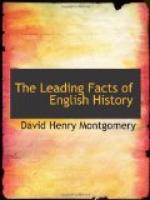[1] Stonehenge: This remarkable structure is believed to be the remains of a pre-historic monument to the dead, which was, perhaps, used also as a place of worship. It stands on Salisbury Plain about nine miles northeast of the city of Salisbury. (See map facing p. 38.) It consists of a broken circle of huge upright stones, some of which are still connected at the top by blocks of flat stones. Within this circle, which is about one hundred feet in circumference, is a circle of smaller stones. The structure has no roof. The recent discover of stains of bronze or copper on one of the great stones, seven feet below the surface, strengthens the theory that Stonehenge was constructed by the race who used bronze implements and who were later known as Britons (S2). Consult Professor C. Oman’s “England before the Norman Conquest”; see also R. W. Emerson’s “English Traits,” and O. W. Holmes’s fine poem on the “Broken Circle,” suggested by a visit to Stonehenge.
4. What we owe to Prehistoric Man.
We have seen that the Romans called the Britons “barbarians” (S2). But we should bear in mind that all the progress which civilization has since made is built on the foundations which those primitive races slowly and painfully laid during unnumbered centuries of toil and strife.
To them we owe man’s wonderful discovery of the power to produce fire. To them we are indebted for the invention of the first tools, the first weapons, and the first attempts at architecture and pictorial art. They too tamed the dog, the horse, and our other domestic animals. They also discovered how to till the soil and how to mine and manufacture metals. In fact those “barbarians” who lived in “the childhood of the world,” and who never wrote a line of history, did some things equal to any which history records, for out of wild plants and trees they developed the grains and fruits which now form an indispensable part of “our daily bread.”
Finally, through their incessant struggles with nature, and incessant wars among themselves, those rude tribes learned to establish forms of self-government for towns or larger districts. Many of their salutary customs—their unwritten laws—still make themselves felt in the world.[1] They help bind the English nation together. They do even more than that, for their influence can be traced in the history of newer nations, which, like the American republic, have descended from the great mother-countries of Europe.
[1] For example, parts of the “Common Law” can be traced back, through English “dooms” (decisions or laws), to prehistoric times. See E. A. Freeman in the Encyclopaedia Britannica (10th edition, VIII, 276). The New England “Town Meeting” can be likewise traced back to the German ancestors of the Anglo-Saxons.
[Figures: Carved bone, flint dagger, and bronze spearhead]




